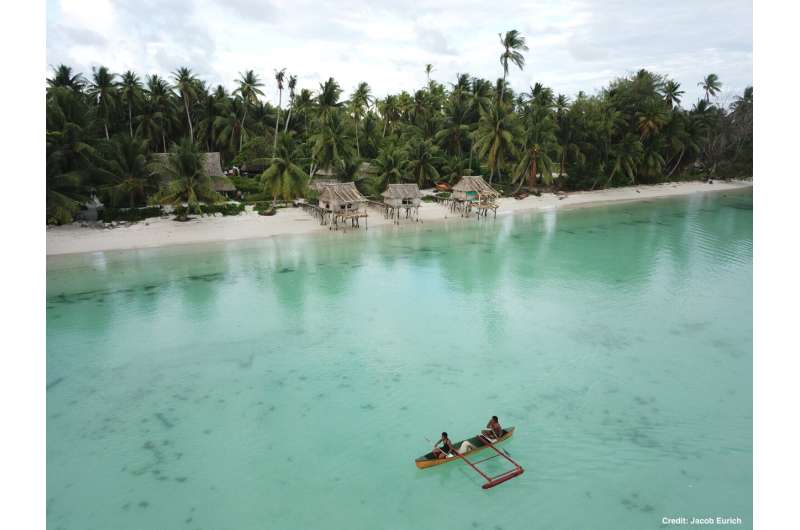This article has been reviewed according to Science X's editorial process and policies. Editors have highlighted the following attributes while ensuring the content's credibility:
fact-checked
peer-reviewed publication
trusted source
proofread
Researchers build and test a framework for achieving climate resilience across diverse fisheries

What makes for a successful climate-resilient fishery, one that sustainably produces resources for human benefit despite increasing climate stressors and human impacts? It's a question that faces present and future fisheries, their practitioners and fishing communities as the world turns to the ocean to feed its growing population.
"For a fishery to be resilient it needs to be able to prepare for, resist, cope with, recover from, or adapt to any given impact," said Jacob Eurich, who is a research associate at UC Santa Barbara's Marine Science Institute, and a fisheries scientist at the Environmental Defense Fund (EDF). "In most cases a fishery will need to have a combination of these capacities to continue to produce food, income and well-being to the people who rely on them."
It's not a one-size-fits-all situation, according to Eurich, who led an international cohort of researchers for a paper published in the journal Fish and Fisheries. Because fisheries are complex marine ecosystems that face unique combinations of circumstances across the globe, achieving climate resilience will require equally diverse strategies, he said.
Fortunately, there are climate resilience success stories to draw lessons from. To gain these valuable insights, Eurich and colleagues examined 18 fisheries that expand our knowledge about how resilience operates across the world.
They tested these fisheries' resilience attributes to learn how and why they were able to persist despite climate change and human impact and, importantly, for whose benefit. The researchers then synthesized their findings into fishery archetypes and resilience pathways for other fishery practitioners that aspire to increase levels of resilience and sustainable benefits to society.
Diverse fisheries, diverse strategies
For a fishery to be successful in the face of climate change, it must be effective across ecological, social and governance dimensions—that is, be able to not only support the health and productivity of its resources but also be supported to that end in its operations and its role in society.
"The biggest challenge is that every fishery is different," Eurich said. "Each fishery has different characteristics and operates on different scales, for different reasons and with unique goals."
The survey conducted by the research team—from the Science for Nature and People Partnership (SNAPP) Climate Resilient Fisheries Working Group, which was led by the Gulf of Maine Research Institute (GMRI), Cornell University and EDF and convened at UCSB's National Center for Ecological Analysis & Synthesis (NCEAS)—provided the data for a framework that standardized, prioritized and scored 38 attributes of fisheries and their milieu.
This system allowed the researchers to find strengths and commonalities to which other fisheries under similar circumstances may align to increase their own resilience.
Pathways to resilience
The researchers developed five archetypes of climate-resilient fisheries and detailed two pathways to climate resilience. They found that in some fisheries, climate resilience is derived from strong ecological assets and tight-knit communities that promote flexible governance, despite having limited economic avenues outside of fishing. In these fisheries, the non-monetary benefits of fish, such as nutrition and culture, are distributed broadly. However, the shift to globalized economies can disrupt this model.
In other fisheries, robust governance and economic assets drive the efficient conversion of fish into economic benefits. Competition, coupled with access to knowledge and capital for investment, can spur technological advancement, which often results in responsive governance. However, in these fisheries, wealth might become concentrated among the most successful firms, leading to power imbalances and enabling only a select group to withstand losses or capitalize on new economic opportunities posed by climate change.
"We also identified key priority areas, where a deficiency in certain attributes hindered fishery resilience," Eurich added. "Often, fishery practitioners know the climate-ready management interventions needed in their system but political obstacles and a lack of support or capacity block these changes. By taking the time to identify and enhance inhibiting attributes, practitioners can increase the success of long-term interventions."
Next steps
Lily Zhao, a Ph.D. student in the UCSB's Department of Ecology, Evolution and Marine Biology, who co-led the piece, added that "There's still a lot of work to be done to ensure sources of resilience are distributed equitably to support climate adaptation within fishery systems, so I'm excited to see how priority areas we found like equitable and inclusive governance will be built and emphasized in the coming decades."
The framework for assessing fishery resilience and research findings have also been converted to an interactive decision support tool. The Climate-Resilient Fisheries Planning Tool guides users through a six-step process that will provide key elements needed to develop a fishery resilience plan.
More information: Fish and Fisheries (2023). DOI: 10.1111/faf.12790
Journal information: Fish and Fisheries
Provided by University of California - Santa Barbara



















